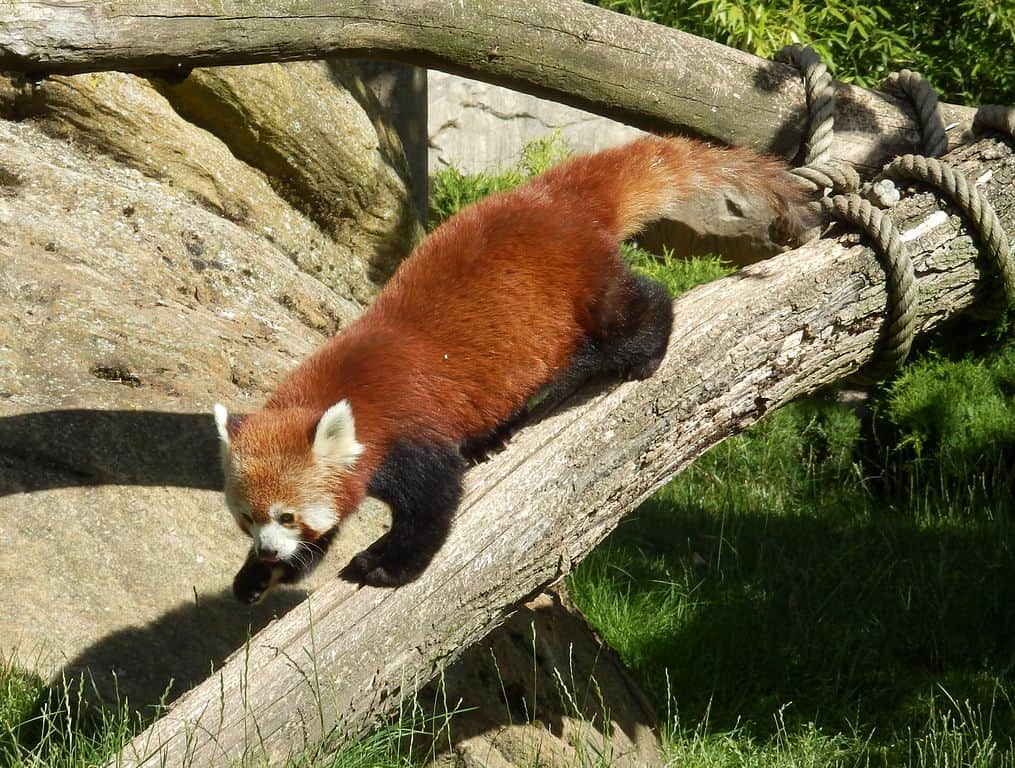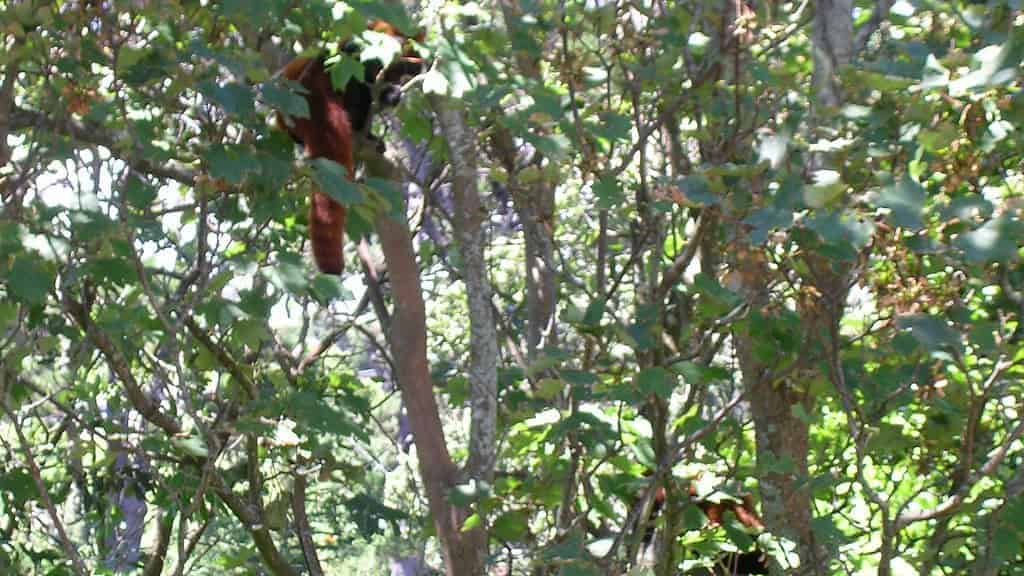Behind their adorable facade and playful antics, red pandas possess remarkable intelligence that often goes unrecognized. These rust-colored mammals, native to the eastern Himalayas and southwestern China, demonstrate cognitive abilities and problem-solving skills that suggest they’re far more intelligent than their cute appearance might lead us to believe. While not traditionally ranked among the world’s smartest animals like dolphins or great apes, red pandas exhibit numerous behaviors indicating impressive cognitive capabilities. Let’s explore 18 fascinating signs that these endangered creatures are significantly more intelligent than they might initially appear.
17. Advanced Problem-Solving Abilities

Red pandas display remarkable problem-solving skills when faced with challenges in their environment. In captivity, researchers and zookeepers have observed them figuring out complex feeding puzzles designed to provide enrichment. They can manipulate objects, determine cause-and-effect relationships, and persist until they achieve their goal—behaviors that indicate higher cognitive functioning.
What’s particularly impressive is how they approach novel situations. Unlike some animals that rely solely on trial and error, red pandas seem to assess a situation before acting, sometimes appearing to plan their approach. This suggests they possess the ability to mentally model potential solutions—a sophisticated cognitive process typically associated with more traditionally “intelligent” species.
16. Sophisticated Tool Usage

Though not as documented as tool use in primates or corvids, red pandas have been observed using objects in their environment in purposeful ways. They may use branches to reach food items or manipulate objects to create comfortable resting spots. While not crafting tools in the way chimpanzees or crows might, their ability to repurpose objects in their environment demonstrates a level of resourcefulness and intelligence.
In captivity, they’ve been seen using provided enrichment items in creative ways not anticipated by their caretakers—such as stacking objects to reach higher areas or using particular items as “stepping stones” to access difficult spots. This adaptability in using available resources speaks to their problem-solving capabilities and suggests a deeper understanding of their physical world.
15. Excellent Spatial Memory

Red pandas demonstrate exceptional spatial memory capabilities, essential for survival in their complex forest habitats. They remember the locations of feeding sites across their territory and can navigate efficiently through the three-dimensional space of the forest canopy. This spatial intelligence helps them track seasonal food availability and recall the locations of escape routes when threatened.
Research suggests they can maintain these mental maps over extended periods, returning to specific trees that produce fruit seasonally or remembering safe denning locations across multiple seasons. Their ability to maintain this cognitive map of their territory—which can span up to 2.5 square kilometers in the wild—is particularly impressive given their relatively small body size and brain.
14. Adaptive Learning Behaviors

Red pandas demonstrate impressive adaptive learning abilities, quickly adjusting their behaviors based on environmental changes. Zoo studies have shown they can learn new feeding techniques when presented with altered food sources or modified enrichment activities. This adaptability extends to their wild behavior, where they adjust foraging patterns in response to seasonal changes in bamboo quality and availability.
What’s particularly notable is how they retain and transfer this learned knowledge. Red pandas have been observed applying solutions from one problem to similar but different challenges, suggesting they’re not just memorizing specific actions but understanding underlying principles. This cognitive flexibility is a hallmark of higher intelligence among mammals and indicates their problem-solving abilities extend beyond simple conditioning.
13. Complex Communication Systems

Despite their reputation for being relatively quiet animals, red pandas actually employ a sophisticated array of vocalizations and body language to communicate. They use at least 11 different vocalizations, including whistles, squeals, and a peculiar “quack-snort” sound, each serving different social functions from warning signals to mating calls. This varied acoustic repertoire suggests a nuanced communication system that conveys specific information about their environment and internal states.
Their body language is equally complex, with tail positions, ear orientations, and facial expressions all conveying different messages to conspecifics. Mother red pandas communicate extensively with their cubs through vocalizations and tactile cues, helping teach them essential survival skills. This multi-channel communication system indicates cognitive complexity and social intelligence that belies their seemingly simple, solitary nature.
12. Cunning Predator Avoidance Strategies

Red pandas have developed sophisticated strategies to avoid their natural predators, demonstrating a level of strategic thinking beyond basic instinct. When threatened, they’ve been observed creating diversionary tactics, such as temporary displays of aggressive behavior followed by escape in an unexpected direction. This suggests an understanding of their predators’ psychology and the ability to manipulate expectations—a remarkably advanced cognitive trait.
They also demonstrate selective response to threats, distinguishing between genuine dangers and false alarms based on subtle environmental cues. In captivity, red pandas quickly learn which human activities represent no threat and which might warrant caution. This threat assessment capacity requires advanced cognitive processing to evaluate complex sensory information and make appropriate decisions—a sign of their underestimated intelligence.
11. Remarkable Dexterity and Fine Motor Control

Red pandas possess extraordinary dexterity that rivals that of many primates, particularly in their forepaws. They have a modified wrist bone that functions somewhat like a thumb, allowing them to grasp and manipulate objects with precision. This manual dexterity is directly connected to neural development and indicates significant brain capacity dedicated to fine motor control—often a marker of higher intelligence in the animal kingdom.
The cognitive implications of this dexterity are substantial. Red pandas can manipulate complex objects, open containers designed to be challenging, and handle their bamboo food source with remarkable precision. They strip bamboo leaves with methodical efficiency, a task requiring both fine motor skills and sequential processing abilities. This combination of physical capability and cognitive coordination suggests neural complexity typically associated with more recognized intelligent species.
10. Sophisticated Social Intelligence

While typically characterized as solitary animals, red pandas display nuanced social intelligence when they do interact with conspecifics. They maintain complex territories with overlapping boundaries, requiring them to navigate sophisticated social rules about when and where interactions are appropriate. During breeding season, they engage in elaborate courtship rituals that demand significant social awareness and communication skills.
Perhaps most telling is their ability to maintain long-term social memory. Red pandas can recognize individuals they’ve previously encountered even after extended periods of separation, adjusting their behavior based on past interactions. This social recognition suggests they maintain mental representations of other individuals and their relationships—a sophisticated cognitive ability typically associated with highly social species rather than predominantly solitary ones like the red panda.
9. Innovative Foraging Techniques

Red pandas have developed specialized foraging strategies that demonstrate impressive cognitive flexibility and innovation. While bamboo constitutes up to 95% of their diet, it’s a challenging food source with low nutritional value. Red pandas have learned to selectively consume the most nutritious parts—leaf tips and tender shoots—while leaving the less valuable portions, showing an understanding of food quality and nutritional needs beyond simple preference.
When bamboo is scarce, they display remarkable resourcefulness, expanding their diet to include fruits, insects, bird eggs, and small vertebrates. Observers have documented red pandas developing unique techniques to access these alternative food sources, such as strategic approaches to raiding birds’ nests or specific methods for capturing insects. This dietary adaptability and development of specialized foraging techniques indicates significant problem-solving abilities and cognitive flexibility.
8. Advanced Parental Strategies

Mother red pandas demonstrate sophisticated parenting behaviors that suggest higher cognitive functioning. They build complex, weatherproof nests for their cubs, often incorporating multiple chambers and carefully selected materials for insulation. This construction requires planning, material assessment, and spatial reasoning—all hallmarks of advanced cognition. They’re also attentive to predator risk when selecting den sites, balancing multiple factors in their decision-making process.
The teaching behaviors displayed by mother red pandas are perhaps most indicative of their intelligence. They gradually introduce cubs to climbing skills through structured experiences, starting with low branches and progressively moving higher as cubs develop confidence. This scaffolded learning approach—where difficulty increases incrementally as skills develop—mirrors teaching methods used by humans and other highly intelligent species, suggesting red pandas possess a form of pedagogical understanding.
7. Cognitive Enrichment Responses

Red pandas in captivity show distinctive responses to cognitive enrichment that suggest higher intellectual capabilities. Zookeepers report that red pandas quickly become bored with simple enrichment activities and require increasingly complex challenges to maintain engagement. This need for novel cognitive stimulation parallels what’s observed in great apes, elephants, and dolphins—animals widely recognized for their intelligence.
Particularly telling is how red pandas approach enrichment puzzles. Unlike some species that rely on repetitive attempts, red pandas often appear to study a puzzle before attempting to solve it. They’ve been observed watching keepers set up enrichment devices, seemingly understanding that human actions provide clues to the solution. This observational learning and apparent forethought suggest cognitive processes beyond what their small size and cute appearance might lead us to expect.
6. Innovative Thermoregulation Behaviors

Red pandas have developed remarkably intelligent approaches to managing body temperature in their variable mountain habitats. Their thick fur provides insulation in cold temperatures, but presents challenges in warmer weather. Rather than relying solely on physiological mechanisms, red pandas use cognitive strategies to thermoregulate, selecting resting locations based on microclimate conditions and time of day. They’ll move between sunny patches and shaded areas throughout the day, demonstrating an understanding of how environmental conditions affect their comfort.
In captivity, caretakers have observed red pandas creating their own cooling solutions during hot weather, such as deliberately wetting their fur before lying in front of ventilation areas or using provided ice blocks in strategic ways to cool specific body parts. This inventive approach to temperature management shows problem-solving skills and an understanding of cause and effect relationships that indicates significant cognitive capabilities.
5. Calculated Risk Assessment

Red pandas demonstrate sophisticated risk assessment abilities that go beyond instinctual responses. When navigating through the forest canopy—where a fall could be fatal—they carefully test branch strength before committing their weight and plan complex routes that balance efficiency with safety. This calculated approach to movement suggests they’re mentally mapping their environment and evaluating multiple factors simultaneously.
Their risk assessment extends to novel situations as well. When encountering unfamiliar objects or environments, red pandas typically display a measured investigation process—first observing from a distance, then approaching cautiously, and finally interacting directly once they’ve determined safety. This graduated response to novelty indicates they’re processing complex information about potential threats and benefits, weighing unknowns against potential rewards in a way that suggests advanced cognitive processing.
4. Selective Attention Capabilities

Red pandas display impressive selective attention abilities, focusing intently on relevant stimuli while filtering out distractions. This cognitive skill is particularly evident during bamboo processing, where they methodically strip and consume the most nutritious parts while ignoring less valuable portions. This selective attention requires significant neural processing to distinguish subtle differences in food quality—a cognitive ability that supports efficient foraging.
Research in captive settings has demonstrated that red pandas can maintain focus on complex tasks even when confronted with significant distractions. During problem-solving activities, they often demonstrate sustained concentration until they achieve their goal, ignoring peripheral activities that might divert less cognitively sophisticated animals. This ability to maintain focus on relevant information while filtering out noise is a hallmark of higher cognitive function typically associated with more recognized intelligent species.
3. Self-Awareness Indicators

While red pandas haven’t been subjected to formal mirror tests for self-recognition (the gold standard for animal self-awareness), they display behaviors suggesting some degree of self-awareness. Captive red pandas engage in deliberate self-grooming behaviors that target specific body areas they cannot see directly, indicating an understanding of their physical self. They also display appropriate adjustment of their movements in tight spaces, suggesting awareness of their body dimensions and position.
Perhaps most intriguing are observations of red pandas appearing to assess their own abilities before attempting challenging climbs or jumps. They seem to evaluate distances and their own capabilities, sometimes opting for alternative routes when a leap appears too challenging. This apparent self-assessment suggests a rudimentary understanding of their own physical capabilities and limitations—a foundational aspect of self-awareness that indicates more sophisticated cognition than they’re typically credited with.
2. Weather Prediction Behaviors

Red pandas appear to anticipate weather changes and adjust their behavior accordingly, suggesting cognitive abilities related to pattern recognition and prediction. Zookeepers and field researchers have noted that red pandas often begin building more substantial nests or seeking more protected areas before visible signs of incoming storms. This predictive behavior indicates they’re processing subtle environmental cues—perhaps changes in barometric pressure, humidity, or distant sounds—and making decisions based on anticipated future conditions.
In their natural habitat, red pandas have been observed harvesting extra bamboo before heavy snowfall events, essentially creating food caches that will sustain them when foraging becomes difficult. This preparation for future conditions suggests temporal understanding and planning capabilities—cognitive abilities traditionally associated with more recognized intelligent species. Their ability to connect present environmental cues with future conditions demonstrates cognitive sophistication beyond simple reactive behaviors.
1. Emotional Intelligence and Empathy

Red pandas display behaviors suggesting emotional complexity and potential empathy, particularly in mother-cub relationships. Mother red pandas respond differently to different types of distress calls from their cubs, providing appropriate care based on the specific need communicated. This nuanced response to emotional signals indicates sophisticated emotional processing rather than simple instinctual reactions.
In captivity, paired red pandas have been observed engaging in what appears to be comfort-seeking and comfort-providing behaviors during stressful situations, such as veterinary procedures or environmental changes. While scientific studies specifically examining empathy in red pandas are limited, these observations suggest capacity for recognizing and responding to others’ emotional states—a component of emotional intelligence that correlates with higher cognitive functioning in other species. This emotional sophistication adds another dimension to their underappreciated intelligence.
Conclusion: Redefining Our Understanding of Red Panda Intelligence

The evidence presented across these 18 signs demonstrates that red pandas possess cognitive abilities far more sophisticated than their cute appearance and popular perception might suggest. From their problem-solving capabilities and tool usage to their complex communication systems and emotional intelligence, red pandas exhibit numerous markers of advanced cognition typically associated with animals widely recognized as intelligent. This cognitive sophistication has likely evolved as an adaptation to their challenging ecological niche, where they must navigate complex forest environments and process a difficult diet with low nutritional value.
Understanding red panda intelligence has important implications for their conservation. As one of the world’s most endangered mammals, red pandas face significant threats from habitat loss and poaching. Recognizing their cognitive complexity should inform conservation strategies, particularly regarding habitat preservation that maintains the environmental complexity these intelligent animals need to thrive. Additionally, in captive breeding programs critical to the species’ survival, acknowledging their intelligence should guide the development of appropriate enrichment protocols that provide the cognitive stimulation these animals require for psychological well-being.
Perhaps most importantly, recognizing red panda intelligence challenges our tendency to correlate cuteness with cognitive simplicity. Their adorable appearance and playful behavior have sometimes led to their characterization as simply “charming” rather than “intelligent” animals. This cognitive underestimation affects not only how we perceive red pandas but potentially how we allocate conservation resources and design management programs. By recognizing the sophisticated intelligence behind their endearing facade, we gain a more complete understanding of these remarkable animals and a greater appreciation for the diversity of cognitive adaptations in the animal kingdom.
- 10 U.S. States Where You Are Likely to Spot a Wild Fox - August 18, 2025
- Salmon Swim Upstream for Miles to Lay Their Eggs But What Guides Them Home - August 18, 2025
- 9 Snakes That Love the Desert And 6 That Need Moisture - August 18, 2025

